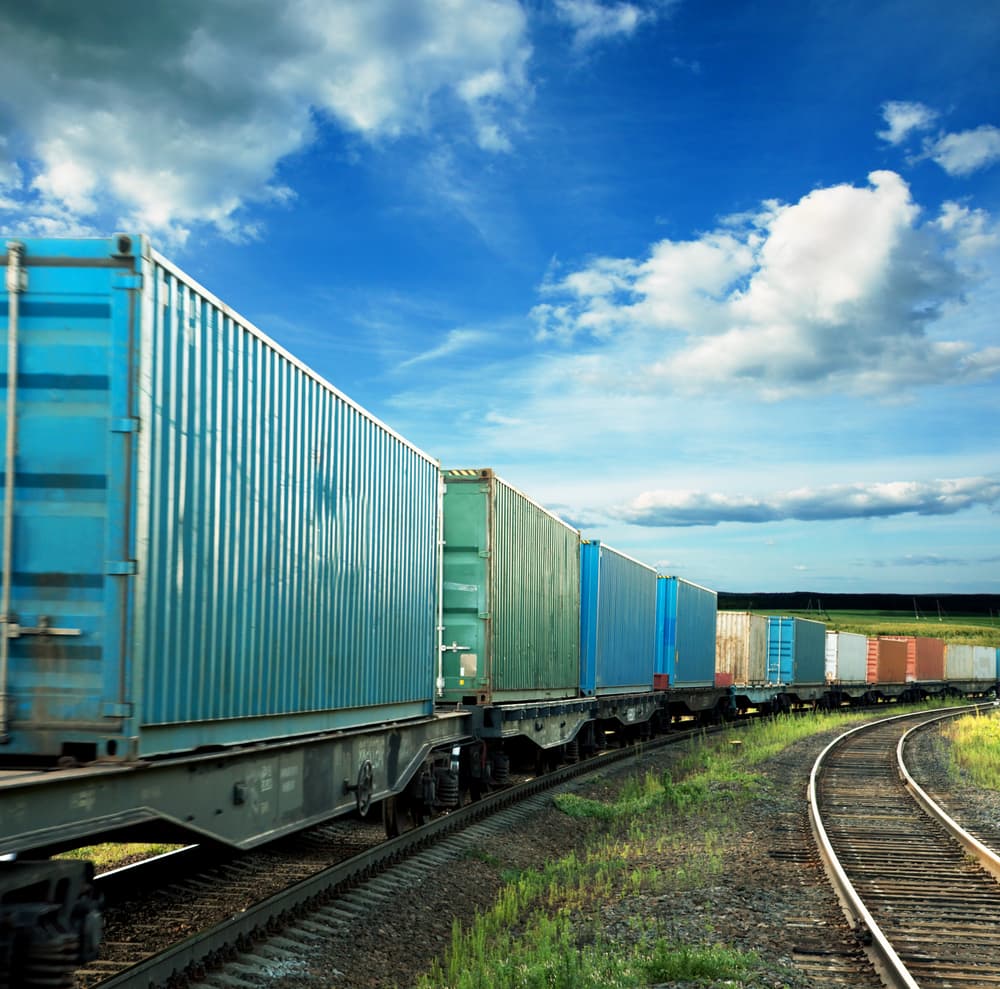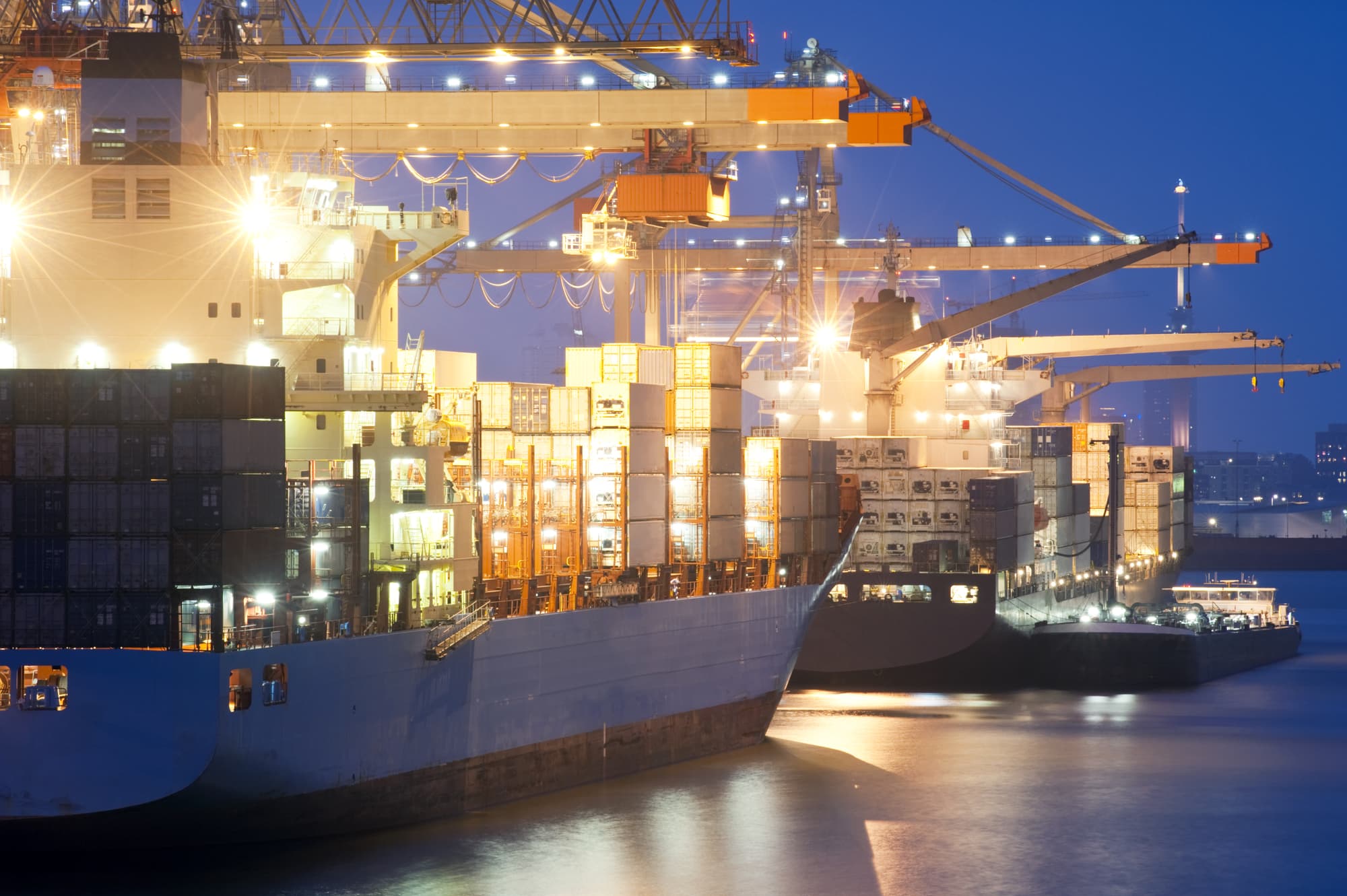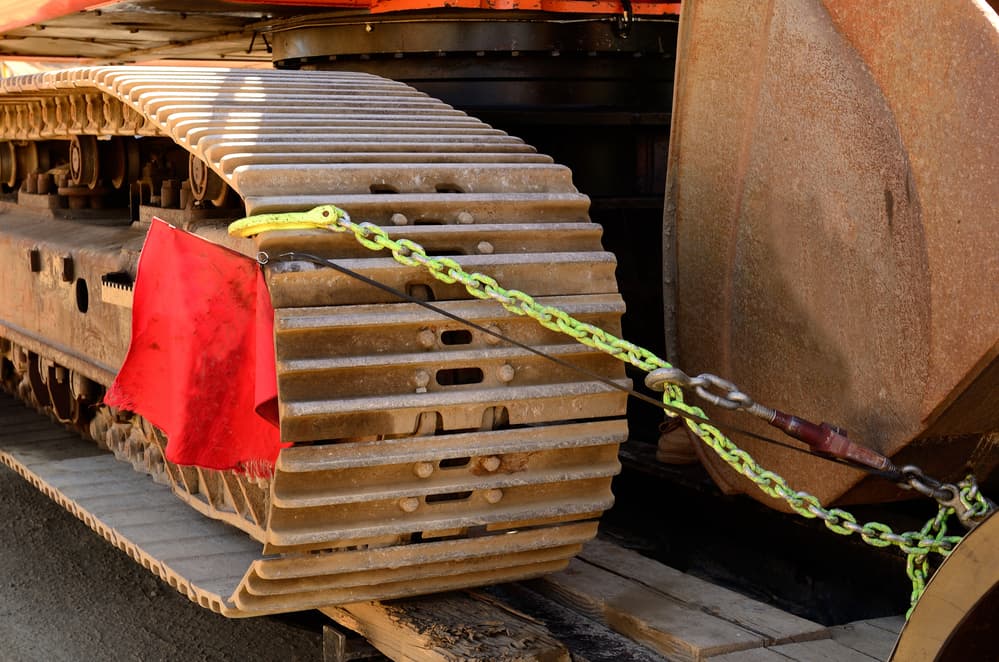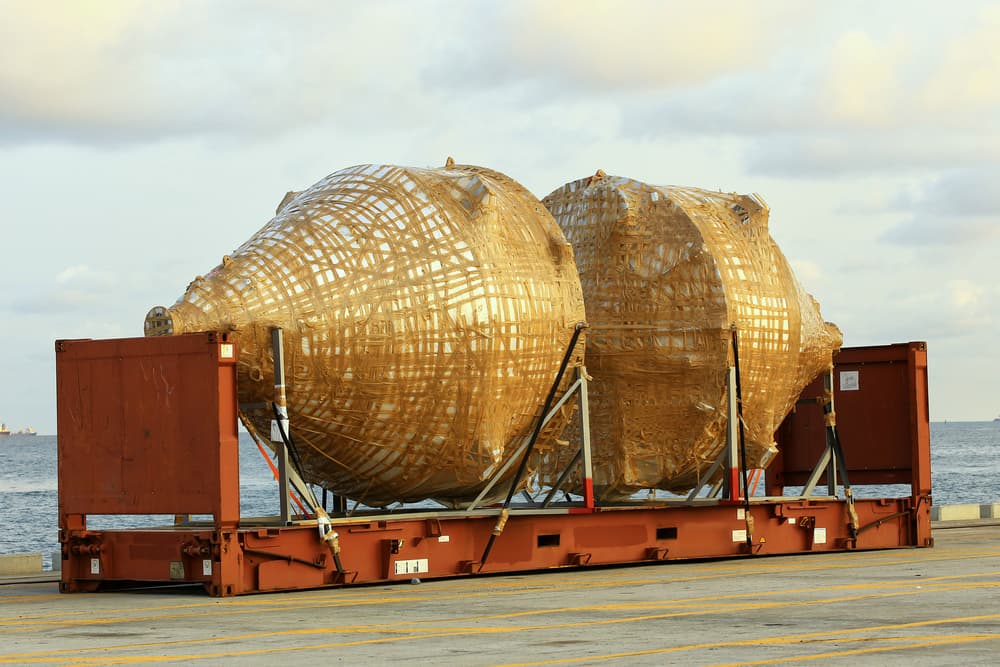Audio:
Guide Contents
Economies pivot on shipping.
The process of freight hauling and the industry that surrounds it are crucial for any functioning economy. Because no communities are completely self-sustaining, keeping supply chains moving efficiently is essential for the continued success of communities around the world.
One huge reason why an efficient supply chain is so important is its role in supporting the shipping of heavy equipment purchases necessary to build and maintain infrastructure—from roads and waterways to businesses, factories, farms, and much more.
In this guide, we’re going to an overview of how to ship heavy equipment—from trucks, trailers, and construction equipment to agricultural equipment and more—the smart way.
In the world of shipping heavy equipment, there are four common methods—container shipping, LoLo, RoRo, and flat rack. (Don’t worry—we’ll explain.)
Which selection or combination of shipping methods used for shipping a particular piece of heavy equipment depends on the specifications of said heavier equipment, the required path of travel, and accommodations upon arrival.

“Can heavy equipment be shipped via container?”
Due to their protective capacities, streamlined moving abilities, and even stackability in many instances, moving goods and equipment via shipping containers has been a popular mode of transport for nearly 70 years.
Shipping containers adapt to various size needs—with sizes running from 20 to 53 feet. The sealed construction of means no fear of damage from the elements or cargo shifting while in transit. Whether cargo needs to move via ship, rail, or truck, shipping containers allow shipping companies to transport heavy loads efficiently.

“What does LoLo mean in shipping terms?”
“LoLo” or “LO/LO” is shortened terminology for “lift-on, lift-off”—which are the actions taken by cranes, derricks, and other lifting equipment for moving items of cargo from ships and other vehicles. LoLo ships contain their own cranes for offloading or onboarding cargo.
LoLo shipping is attractive in that it does not require the operation of heavy equipment to facilitate loading—no driving of trucks, tractors, or construction equipment. They’re simply lifted on and lifted off as needed like any other immobile cargo—resulting in lowered emissions, equipment wear, and shipping logistics.

“What does RoRo mean in shipping terms?”
As opposed to loading on and loading off heavy equipment (LoLo), RoRo shipping refers to rolling on and rolling off said wheeled or tracked pieces of equipment—such as trucks, construction equipment, or agricultural equipment. In this way, it can be said that RoRo shipping acts almost like an industrial ferry for said vehicles—either on and off ships or trailers.
For items of heavy equipment that are not self-propelled, such as heavy trailers, in a RoRo scenario, they are hauled or wheeled into position on their proper shipping vessel or other mode of transport.
The RoLo transport method also includes shipping equipment on various trailer types, such as lowboy and hotshot trailers. The type of trailer used by the transportation company is important, as standard load trailer models won't be equipped to handle overweight loads and wider loads—dimensions common of industrial machinery, such as mining equipment, and other such machines used by heavy industry.

“What does ‘flat rack’ mean in shipping terms?”
Unlike fully closed shipping containers, flat rack shipping for heavy equipment means that the heavy equipment cargo containers allow for a certain amount of side overhang.
Whereas shipping containers are like shoe boxes, flat rack containers are much more like large 20-foot or 40-foot industrial shelves or flat trailers for heavy equipment. Flat rack containers are ideal for oddly shaped bulkier heavy equipment that doesn’t fit neatly into conventional containers. Many flat track containers contain pockets for forklifts or gooseneck tunnels for easy moving. Heavy machinery shipments transported on flat racks may be protected with heavy-duty tarps or left exposed if it is designed to withstand various weather conditions.
Equipment Shipping Down the Home Stretch
In the final steps of shipping, most items of heavy equipment will arrive on specialty trailers—often heavy cargo trailers and other hauling equipment designed to handle wide loads beyond the capacity of a standard trailer. These usually require the aid of specialized equipment for transport, the services of an escort vehicle to ensure successful road travel, and possibly the use of specialized ramps.
“What information does my shipping provider need from me?”
To ensure the safety of your heavy equipment cargo as well as the shipping company’s equipment, there are various pieces of information they will need.
- The make, model, and any relevant identification numbers associated with your heavy equipment
- Any modifications that may impact how the equipment is moved or handled
- The precise specification of the equipment—including dimensions and weights
- Equipment protection needs—including the need for weather protection, pallet support, or crating
- Images of your heavy equipment to help shippers determine the most appropriate shipping methods
“How much does it cost to ship heavy equipment?”
While it would be nice to provide a cost menu for shipping heavy equipment based on item dimensions and the distance traveled, calculating the cost of heavy equipment shipping is fairly complicated. There are many different criteria to consider to begin to draft a transportation cost estimate for such cargo shipping, including—
- Heavy equipment weight and dimensions
- Departure and arrival points—including which taxes, special permits, tariffs, customs, and other fees are required when crossing various borders, boundaries, or territories
- The cost of freight insurance coverage for items in transit and what levels of protection are required, available, and appropriate
- Additional costs and fees required by heavy equipment transporters
- Any issues that may impede international shipping
- Weather issues that may impact heavy equipment transport at sea or along roadways
The cost to ship heavy equipment will depend on the freight class of a particular load. According to the National Motor Freight Traffic Association, there are 18 different freight classes—labeled from class 50 to 500. These freight classes are largely determined by the density of the item.
To determine the density of your heavy equipment shipment is calculated with a fairly straightforward formula:
- Height x Length x Width = the cubic inches of your load
- Divide the cubic inches by one cubic foot, or 1,728 cubic inches
- Divide the Weight of your shipment by the total number of cubic feet, as previously determined
This should give you your heavy freight density, but if you’d like additional reassurance, the NMFTA has helpful Freight Class Calculator online for you to use.
How quickly you need your heavy equipment to arrive at its intended destination country or location will impact the cost of shipping. Higher priority comes at a higher price. However, prices may also be subject to demand. Busier seasons increase demand as well as prices. Lower demand means more open spaces on shipping vessels, trains, or trucks—resulting in discounted rates. Depending on when and where heavy equipment is needed, you may be able to save big on shipping by choosing the right time of year to ship cargo.
Established shipping companies provide limited liability coverage for shipped cargo. This means a basic level of freight insurance is provided per cargo type with a rate established by their insurer. While this sounds pretty good, this coverage should be considered fairly basic and may not cover the cost to replace any lost or damaged heavy equipment. The amount of actual coverage provided in the event of shipping accident would depend on the ability to provide evidence of a range of factors—how the cargo was packed, where the damage occurred, who is to blame, and the like.
“Should I opt for additional freight insurance when shipping heavy equipment?”
When calculating the cost to ship your heavy equipment, you should inquire about your shipping company’s maximum liability coverage concerning your particular heavy equipment. When in doubt, it is best to opt for additional insurance coverage that allows you to meet or exceed the replacement cost of any lost or damaged cargo. Don’t leave it solely in the carrier’s hands to make sure your heavy equipment is adequately insured.
For assistance with this and many other heavy machinery shipping concerns, you may also consult a freight broker.
Navigating the process of shipping heavy equipment is fairly complex—a process many heavy equipment buyers and sellers prefer to leave to shipping industry professionals to manage most facets of their heavy machinery shipping needs. These third parties freight coordination specialists are known as freight brokers.
Simply put, a freight broker is a mediator between shippers and shipping service companies. They work to simplify the shipping process and ensure that all facets of the transport are taken into consideration. Freight brokers are industry professionals—and as such, they're only familiar with ins and outs of shipping, but also economic conditions that impact the price of moving goods across state lines, borders, or even oceans.
“How much does a freight broker cost?”
The average freight broker manages many shipping logistics and other details in return for about 15%-20% of the cost of shipping. While this may feel steep, between the savings they may recover as well as headaches avoided thanks to their understanding of shipping requirements, this is a small price to pay to make sure all details are accounted for. Freight brokers often work for or alongside international shipping and heavy equipment transport companies.
When hiring freight brokers or shipping companies, it is not a bad idea to shop around a bit, request quote estimates, and even ask previous customers of said entities if they would recommend them. Like any expensive and sensitive service, it pays to investigate providers to ensure your equipment will arrive safe, on time, and on budget.
Company Snapshot
Also, when investigating a heavy equipment shipping provider, it doesn’t hurt to receive a Company Snapshot—an electronic confirmation of a company’s legitimacy and safety rating. You can do this easily to the Federal Motor Carrier Safety Administration’s Company Snapshot tool.
Shipping heavy equipment is a very specific niche of shipping. Not only is heavy machinery cargo quite heavy and bulky but it can also be oddly shaped, have unique handling requirements, and the like. The following are some questions you’ll want to consider and account for when speaking with a shipping company and/or freight broker.
- Can your heavy equipment fit within a single shipping container, on a standard flatbed trailer, or will it require dismantled transit?
- Does it make sense to distribute the weight of a piece of machinery across two containers?
- Will the heavy equipment need to be shipped by sea, inland waterway, rail, truck trailer, or any combination of these?
- What kind of bracing and support does this heavy equipment require during transit?
- What kind of moisture protection does the equipment require?
- What capacity crane will be necessary to lift said heavy machinery?
- What legal permits or other special permits will need to be obtained to move this cargo across within compliance with customs regulations through its destination port?
- If you’re importing vehicles and engines into the country, is your shipping provider abiding by EPA regulations concerning importing vehicles and engines?
- Will shippers need to be able to operate the heavy equipment move it (such as a RoLo situation)?
- How will the machinery cargo need to be prepared for shipment (cleaning, permitted or required fuel levels, and the like)?
- Will your equipment require an oversized load trailer to travel on highways or will standard flatbed trucks suffice?
- Does your heavy equipment transport company have the proper oversize/overweight load permits—as defined by the Federal Highway Administration?
- What escort vehicles will be required to accompany oversized load trailers and have these been arranged?
- Are all specialized trailer ramps to necessary offload equipment contained on the trailers, provided by the transport companies, or will they need to be provided upon receiving said oversize load?
- Are there any legal permits or other documentation that will be necessary to streamline the heavy equipment shipping process on the recipient's side?
There’s a good chance that the operator's manual for a particular item of heavy equipment can provide immense guidance about how to safely and effectively ship said model of equipment. If you no longer possess this manual, PDF versions can usually be found online through the manufacturer or a third-party source.
Whether you’re in the market for heavy equipment and are comfortable with casting a wide net or you’d like to be able to sell heavy equipment to buyers in faraway lands, understanding how heavy equipment shipping works is helpful for both buyers and sellers.
Heavy Equipment Buyers
If you’re in the market for heavy equipment, your friends at My Little Salesman are happy to help you with tens of thousands of seller listings to help you find the perfect model for your needs.
Find and ship the special equipment you need to get the job done today.
Heavy Equipment Sellers
If you’re ready to increase the visibility of your heavy equipment inventory for hundreds of thousands of potential buyers, your friends from My Little Salesman have made doing so quick, easy, and affordable.
List your heavy equipment inventory online today.